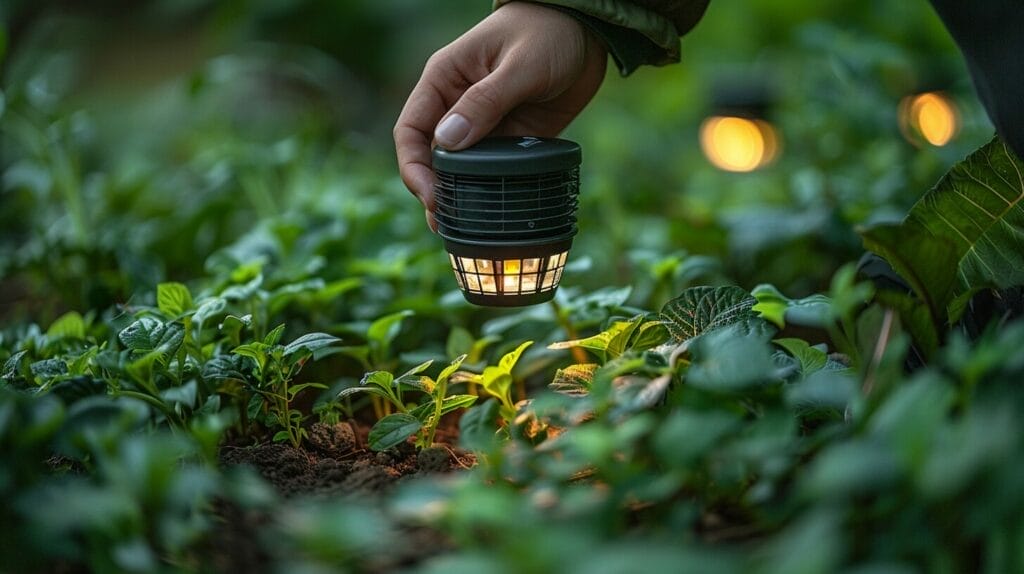Charging Solar Lights First Time: A Guide for Beginners
So, you’ve got yourself a shiny new set of solar lights, and you’re ready to bask in the eco-friendly glow of renewable energy.
But hold on there, before you start envisioning your garden alight with sustainable brilliance, there’s a vital first step you need to take. Charging solar lights for the first time might seem straightforward, but there are some key tips and tricks that could make all the difference in how well they perform.
Trust our Charging Solar Lights First Time guide, you’ll want to know these insights to guarantee your solar lights shine bright when the sun goes down.
Key Takeaways
- Place new solar lights in direct sunlight for initial 6-8 hour charge.
- Monitor manufacturer indicators for full charge indication.
- Use artificial light sources strategically for efficient charging.
- Ensure regular maintenance for prolonged performance and efficiency.
Understanding How Solar Lights Function: The Basics

Solar lights harness sunlight through solar panels, typically located on top of the light. These panels contain photovoltaic cells that convert sunlight into direct current (DC) electricity. The more sunlight the panels receive, the more energy they can produce for the light to function efficiently, a principle fundamental to the efficiency of solar LED lights.
The energy is stored in rechargeable batteries within the solar light, allowing the light to function at night when sunlight isn’t available, highlighting the importance of a robust solar battery in solar-powered lights. It’s crucial to fully charge the batteries initially to optimize the light’s performance, ensuring that your solar-powered lights shine bright.
When the sun sets and the panels stop receiving sunlight, the stored energy powers the LED bulbs within the light, showcasing the effective use of solar batteries in maintaining a bright LED light source through the night. LED bulbs are highly efficient, requiring minimal energy to produce bright light, making them ideal for solar-powered applications.
Step-by-Step Guide: Charging Your Solar Lights for the First Time

To start, unpack your new solar lights and place them in direct sunlight. This initial charge is vital to kickstart the battery and optimize performance. Initial charge time typically ranges from 6 to 8 hours, depending on the model and battery capacity.
Monitor the manufacturer’s indicators, such as a blinking light or a color change, to know when your solar lights are fully charged and ready for use. A well-executed initial charge can extend the overall lifespan of your solar lights and enhance their performance over time, notably for solar landscape lights which greatly benefit from this practice.
Overcoming Challenges: How to Charge Solar Lights Without Sunlight

When sunlight is unavailable, you can charge solar lights using artificial light sources indoors. This can be achieved with a flashlight or bright indoor lights, allowing you to charge your solar lights without the sun. It’s vital to maintain the efficiency of solar lights without natural sunlight for uninterrupted usage.
| Method | Description |
|---|---|
| Use a flashlight | Direct a powerful flashlight towards the solar panel |
| Charge indoors under lights | Place the solar lights under bright indoor lights to charge solar lights indoors. |
| Optimize artificial light | Position the lights strategically to capture the most artificial light |
| Ensure panel exposure | Keep the solar panel unobstructed to maximize light absorption |
Creative solutions like these can keep your solar lights functional when natural sunlight is scarce.
Seasonal Adjustments: How to Charge Solar Lights without the sun in Winter or on a Cloudy Day

During the winter months or on cloudy days, optimizing solar light charging requires strategic placement and utilization of available light sources. Here are some tips:
- Adjust Positioning: Place your solar lights in areas that receive the most sunlight.
- Use Reflective Surfaces: Position mirrors or reflective materials near your solar lights to redirect and amplify available light.
- Invest in Backup Power: Consider purchasing solar lights with larger battery capacities or options for external charging.
- Utilize Artificial Light Sources: In situations where natural light is limited, supplement solar charging with artificial light sources such as LED bulbs, lamps, or solar lamps.
Innovative Charging Solutions: Adapting to Varied Conditions

While direct sunlight is the primary source of energy for solar lights, there are innovative solutions to overcome challenges posed by adverse weather conditions or limited sunlight availability. For instance, on cloudy days or during the winter months when sunlight is scarce, strategic placement of mirrors or reflective surfaces can amplify available light, enhancing the charging capacity of your solar lights.
Additionally, investing in solar lights with larger battery capacities or options for external charging provides backup power reserves, ensuring uninterrupted illumination even in challenging conditions. Integrating artificial light sources such as LED bulbs or lamps further extends the usability of solar lights, offering flexibility in charging options and enhancing their resilience against environmental factors.
By embracing these innovative charging solutions and integrating them into your solar lighting setup, you’ll harness the full potential of renewable energy while maintaining consistent performance and reliability, regardless of external conditions.
Can I Recycle the Solar Lights’ Panels When They Are No Longer in Use?
Yes, you can recycle the solar lights’ panels when they are no longer in use through the solar panel recycling process. This ensures that the materials in the panels are reused, reducing waste and the need for raw materials. It’s an important step in sustainable energy practices.
Maintaining Your Solar Lights: Regular Charging and Care

Regularly charging and caring for your solar lights, including solar LED lights, is essential for peak performance and longevity, signifying the importance of harnessing solar power effectively. It’s recommended to charge your solar lights at least every three months, even if not in use. Clean the solar panels regularly, as dust, dirt, or debris can obstruct sunlight absorption, affecting the charging capacity and preventing the panels from harnessing enough sunlight to make your solar lights function optimally.
Troubleshooting common issues promptly can extend the lifespan of your robust outdoor solar lights. If you notice a decrease in illumination, check the connection points and make sure the panels aren’t shaded. If the issue persists, consider replacing the rechargeable batteries.
Conclusion
Overall, charging solar lights for the first time may seem challenging, but with the right knowledge and care, including tips on how to charge solar lights indoors, it can be a simple and rewarding experience.
By understanding how solar lights work, following a step-by-step guide, and making adjustments for different seasons, you can guarantee your lights stay powered and bright.
Remember to regularly charge and maintain your solar lights to enjoy their benefits for years to come.
Frequently Asked Questions
Can solar lights be charged indoors?
Yes, solar lights can be charged indoors using artificial light sources such as incandescent or LED bulbs.
How can I charge solar lights without sun?
Solar lights can be charged without direct sunlight by placing them under indirect sunlight or using artificial light sources like LED light or incandescent bulbs, demonstrating a lighting solution that does not require direct solar energy.
How long should solar lights be charged for the first time?
It is recommended to charge solar lights for at least 12 hours when charging them for the first time to ensure the battery is fully charged.
Are there any tips on how to charge solar lights on a cloudy day?
To charge solar lights on a cloudy day, place them in an area with indirect sunlight or use artificial light sources like LED bulbs or incandescent light.
Can solar lights be charged with a flashlight?
Yes, solar lights can be charged using a flashlight by placing the flashlight close to the solar panel surface to provide light for charging.







